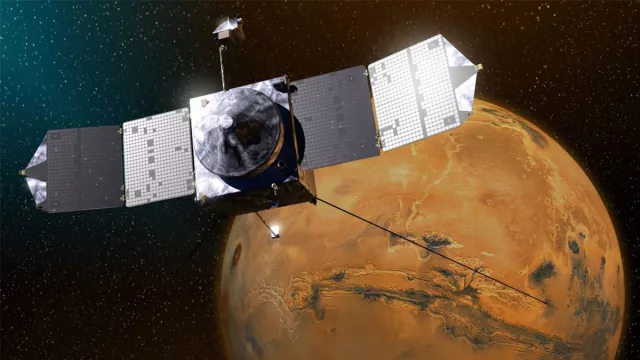Launched on 18 November 2013, the MAVEN spacecraft (Mars Atmosphere and Volatile EvolutioN) is studying Mars’ climate history to elucidate how the planet’s atmosphere was stripped away over time and how it formed and evolved, as well as the history and evolution of liquid water and the ability to support life.
Key information
Key figures
- 8 scientific instruments
- 2,454 kg: spacecraft mass
- 1 contributing French laboratory
- 4 kg: mass of SWEA instrument
Key milestones
- September 2025: Scheduled end of mission
- 5 April 2019: Aerobraking to put spacecraft in better orbit to relay communications with Mars rovers
- 22 September 2014: MAVEN goes into Mars orbit
- 18 November 2013: MAVEN launched by Atlas V 401
- 2 August 2013: MAVEN prepared for launch
- 2006: MAVEN project kicks off
Project in brief
Why is the atmosphere of Mars, once dense and probably enabling liquid water to persist on its surface in the distant past, today so tenuous? This is the enigma the MAVEN spacecraft is attempting to solve since arriving in its working orbit around the red planet on 16 November 2014, after a 10-month journey, in an effort to retrace the history of Mars’ atmosphere and climate. MAVEN is exploring Mars’ upper atmosphere and analysing how it interacts with the Sun and the solar wind, acquiring measurements from its 4½-hour elliptical orbit, at altitudes varying from 150 kilometres to 6,000 kilometres. It has also flown a series of ‘deep dips’ into the upper atmosphere, as low as 125 kilometres from the planet’s surface, to analyse its composition. To accomplish all of these tasks, MAVEN is carrying a suite of eight scientific instruments.
Undertaken in partnership with France, MAVEN is a mission of NASA’s Mars Scout programme. CNES oversaw instrument development by French research laboratories. In particular, the IRAP astrophysics and planetology research institute in Toulouse developed and supplied the Solar Wind Electron Analyzer (SWEA). The mission was originally scheduled to run for one Earth year, with an option to extend it to one Mars year (686 days). It has since been further extended and is still operational.
In February 2019, the mission embarked on a new aerobraking phase to tighten MAVEN’s orbit and ready it to serve as a data-relay satellite for rovers on the surface of Mars. This phase involved another series of deep dips to within 125 kilometres of the surface, enabling further in-situ analyses. By April 2019, it lowered the highest point (apoapsis) of MAVEN’s orbit to 4,500 kilometres.
CNES’s role
CNES oversaw the instrument contributions from French research laboratories, notably for SWEA, developed by IRAP.
Contacts
Project Leader, Solar System Planets and Small Bodies subject matter expert
Francis Rocard
E-mail: francis.rocard at cnes.fr


